HCA 5123 Fall B-18: Cultural and Linguistic Competence Case Study
VerifiedAdded on 2023/06/04
|11
|3050
|253
Case Study
AI Summary
This case study analyzes the National Standards on Culturally and Linguistically Appropriate Services (CLAS) in Health and Health Care. The case explores the key facts and critical issues surrounding the implementation of the 2013 CLAS standards, including potential barriers such as resource limitations, lack of training, and resistance to change. The analysis examines the expanded definitions of health and culture in 2013 compared to 2000, highlighting the shift towards a more holistic and patient-centered approach, influenced by factors like technological advancements and a better understanding of health disparities. The differences between recommendations, guidelines, and mandates are explained, with the case suggesting that the decision to make all enhanced standards guidelines may be due to factors like the voluntary nature of healthcare organizations and the need for flexibility in implementation. The case emphasizes the importance of cultural competence training, effective communication, and the use of technology to improve healthcare outcomes, addressing issues such as health literacy, patient satisfaction, and the reduction of health disparities. The case also highlights the importance of linguistic competence, interpretation services, and the need for healthcare providers to be willing to accommodate all kinds of patients to provide quality health services and reduce inequalities in healthcare.
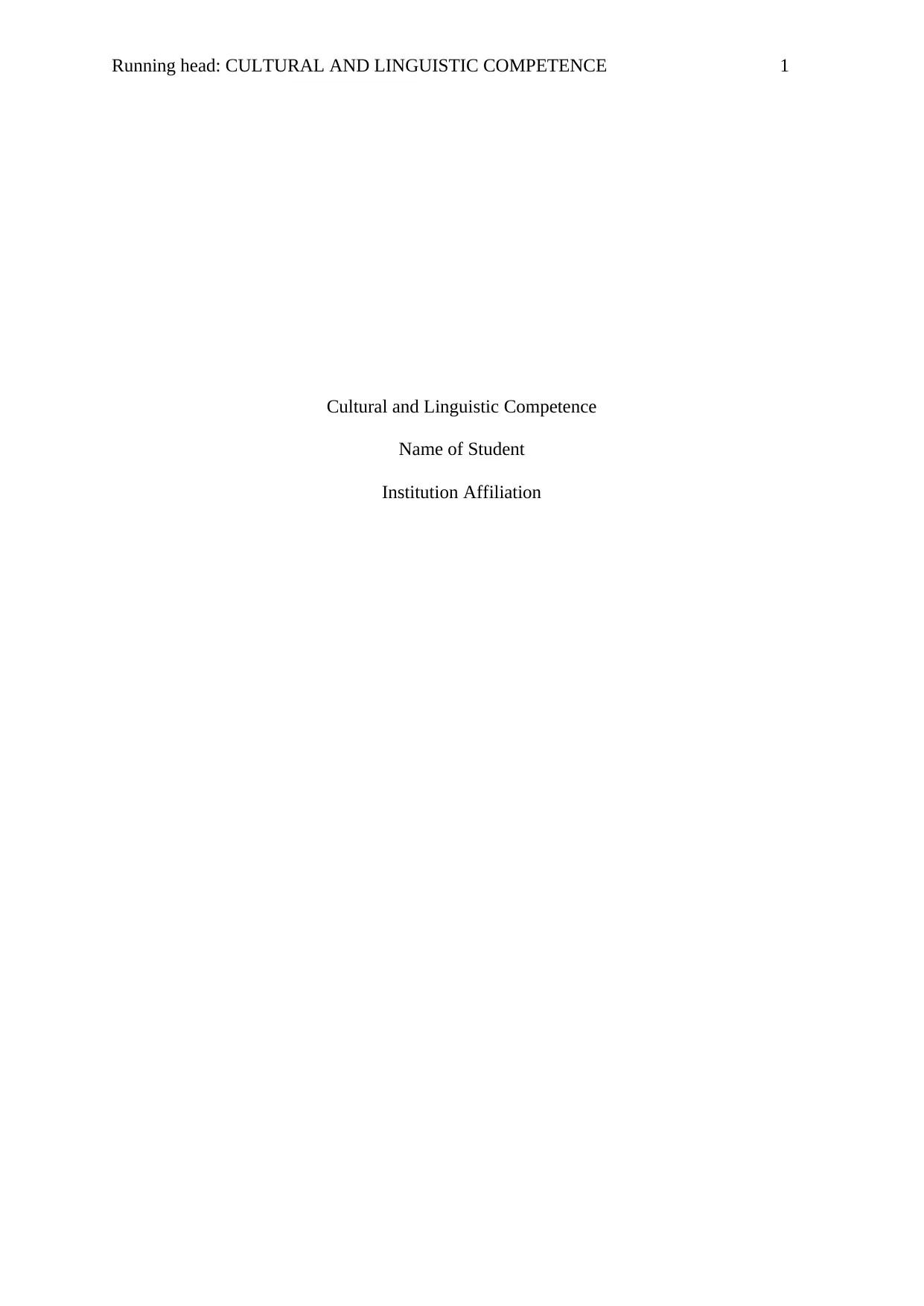
Running head: CULTURAL AND LINGUISTIC COMPETENCE 1
Cultural and Linguistic Competence
Name of Student
Institution Affiliation
Cultural and Linguistic Competence
Name of Student
Institution Affiliation
Paraphrase This Document
Need a fresh take? Get an instant paraphrase of this document with our AI Paraphraser
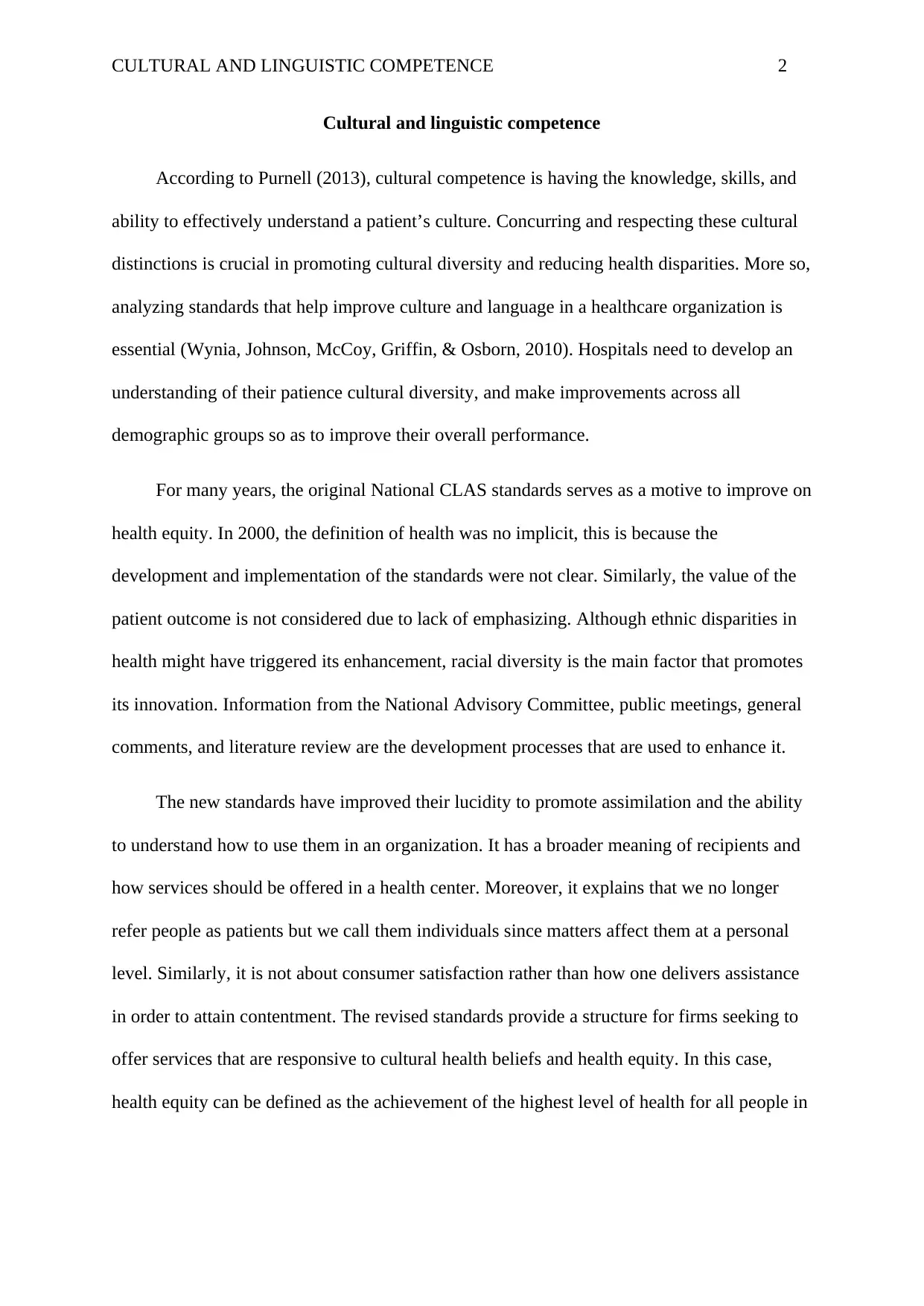
CULTURAL AND LINGUISTIC COMPETENCE 2
Cultural and linguistic competence
According to Purnell (2013), cultural competence is having the knowledge, skills, and
ability to effectively understand a patient’s culture. Concurring and respecting these cultural
distinctions is crucial in promoting cultural diversity and reducing health disparities. More so,
analyzing standards that help improve culture and language in a healthcare organization is
essential (Wynia, Johnson, McCoy, Griffin, & Osborn, 2010). Hospitals need to develop an
understanding of their patience cultural diversity, and make improvements across all
demographic groups so as to improve their overall performance.
For many years, the original National CLAS standards serves as a motive to improve on
health equity. In 2000, the definition of health was no implicit, this is because the
development and implementation of the standards were not clear. Similarly, the value of the
patient outcome is not considered due to lack of emphasizing. Although ethnic disparities in
health might have triggered its enhancement, racial diversity is the main factor that promotes
its innovation. Information from the National Advisory Committee, public meetings, general
comments, and literature review are the development processes that are used to enhance it.
The new standards have improved their lucidity to promote assimilation and the ability
to understand how to use them in an organization. It has a broader meaning of recipients and
how services should be offered in a health center. Moreover, it explains that we no longer
refer people as patients but we call them individuals since matters affect them at a personal
level. Similarly, it is not about consumer satisfaction rather than how one delivers assistance
in order to attain contentment. The revised standards provide a structure for firms seeking to
offer services that are responsive to cultural health beliefs and health equity. In this case,
health equity can be defined as the achievement of the highest level of health for all people in
Cultural and linguistic competence
According to Purnell (2013), cultural competence is having the knowledge, skills, and
ability to effectively understand a patient’s culture. Concurring and respecting these cultural
distinctions is crucial in promoting cultural diversity and reducing health disparities. More so,
analyzing standards that help improve culture and language in a healthcare organization is
essential (Wynia, Johnson, McCoy, Griffin, & Osborn, 2010). Hospitals need to develop an
understanding of their patience cultural diversity, and make improvements across all
demographic groups so as to improve their overall performance.
For many years, the original National CLAS standards serves as a motive to improve on
health equity. In 2000, the definition of health was no implicit, this is because the
development and implementation of the standards were not clear. Similarly, the value of the
patient outcome is not considered due to lack of emphasizing. Although ethnic disparities in
health might have triggered its enhancement, racial diversity is the main factor that promotes
its innovation. Information from the National Advisory Committee, public meetings, general
comments, and literature review are the development processes that are used to enhance it.
The new standards have improved their lucidity to promote assimilation and the ability
to understand how to use them in an organization. It has a broader meaning of recipients and
how services should be offered in a health center. Moreover, it explains that we no longer
refer people as patients but we call them individuals since matters affect them at a personal
level. Similarly, it is not about consumer satisfaction rather than how one delivers assistance
in order to attain contentment. The revised standards provide a structure for firms seeking to
offer services that are responsive to cultural health beliefs and health equity. In this case,
health equity can be defined as the achievement of the highest level of health for all people in
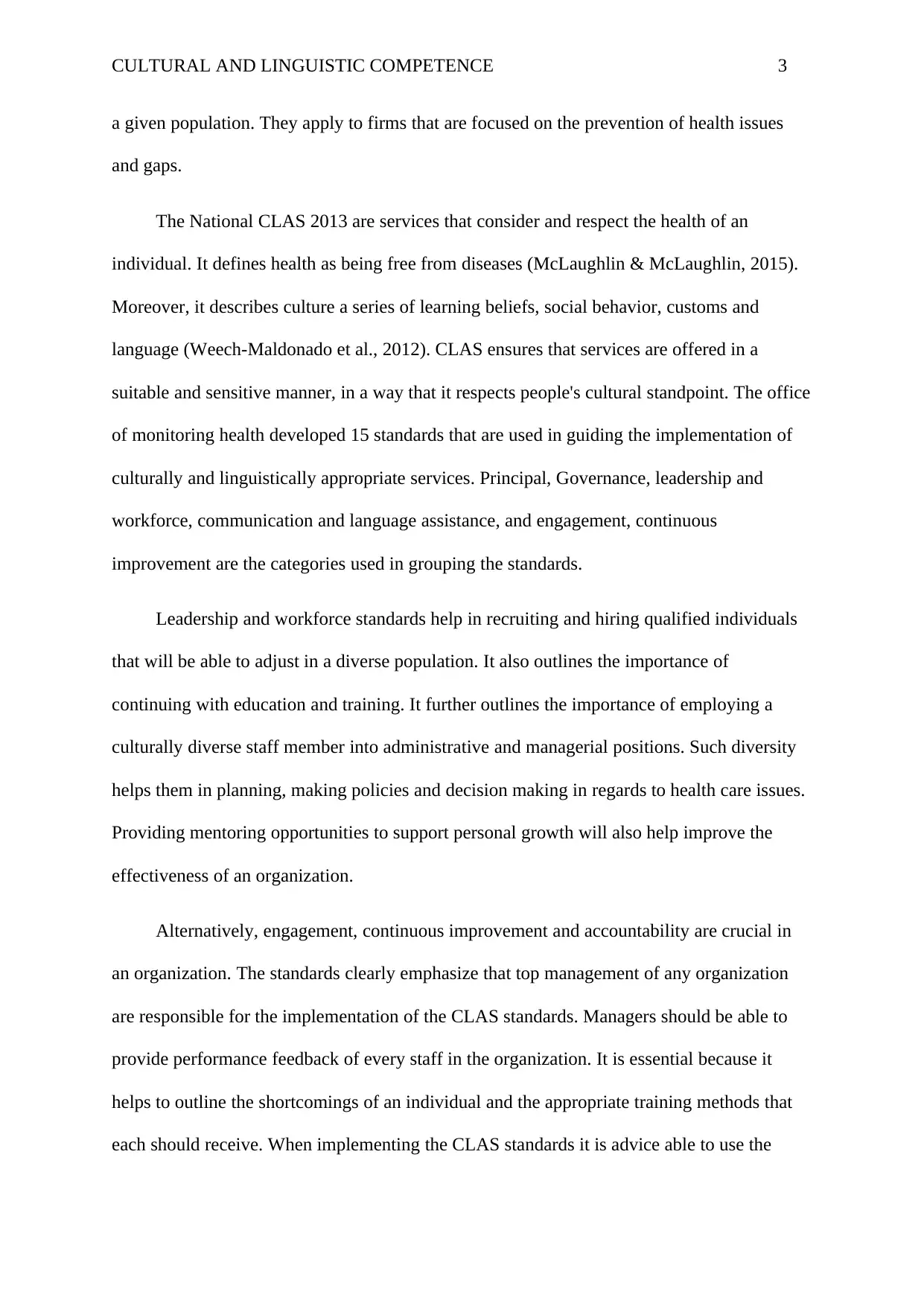
CULTURAL AND LINGUISTIC COMPETENCE 3
a given population. They apply to firms that are focused on the prevention of health issues
and gaps.
The National CLAS 2013 are services that consider and respect the health of an
individual. It defines health as being free from diseases (McLaughlin & McLaughlin, 2015).
Moreover, it describes culture a series of learning beliefs, social behavior, customs and
language (Weech-Maldonado et al., 2012). CLAS ensures that services are offered in a
suitable and sensitive manner, in a way that it respects people's cultural standpoint. The office
of monitoring health developed 15 standards that are used in guiding the implementation of
culturally and linguistically appropriate services. Principal, Governance, leadership and
workforce, communication and language assistance, and engagement, continuous
improvement are the categories used in grouping the standards.
Leadership and workforce standards help in recruiting and hiring qualified individuals
that will be able to adjust in a diverse population. It also outlines the importance of
continuing with education and training. It further outlines the importance of employing a
culturally diverse staff member into administrative and managerial positions. Such diversity
helps them in planning, making policies and decision making in regards to health care issues.
Providing mentoring opportunities to support personal growth will also help improve the
effectiveness of an organization.
Alternatively, engagement, continuous improvement and accountability are crucial in
an organization. The standards clearly emphasize that top management of any organization
are responsible for the implementation of the CLAS standards. Managers should be able to
provide performance feedback of every staff in the organization. It is essential because it
helps to outline the shortcomings of an individual and the appropriate training methods that
each should receive. When implementing the CLAS standards it is advice able to use the
a given population. They apply to firms that are focused on the prevention of health issues
and gaps.
The National CLAS 2013 are services that consider and respect the health of an
individual. It defines health as being free from diseases (McLaughlin & McLaughlin, 2015).
Moreover, it describes culture a series of learning beliefs, social behavior, customs and
language (Weech-Maldonado et al., 2012). CLAS ensures that services are offered in a
suitable and sensitive manner, in a way that it respects people's cultural standpoint. The office
of monitoring health developed 15 standards that are used in guiding the implementation of
culturally and linguistically appropriate services. Principal, Governance, leadership and
workforce, communication and language assistance, and engagement, continuous
improvement are the categories used in grouping the standards.
Leadership and workforce standards help in recruiting and hiring qualified individuals
that will be able to adjust in a diverse population. It also outlines the importance of
continuing with education and training. It further outlines the importance of employing a
culturally diverse staff member into administrative and managerial positions. Such diversity
helps them in planning, making policies and decision making in regards to health care issues.
Providing mentoring opportunities to support personal growth will also help improve the
effectiveness of an organization.
Alternatively, engagement, continuous improvement and accountability are crucial in
an organization. The standards clearly emphasize that top management of any organization
are responsible for the implementation of the CLAS standards. Managers should be able to
provide performance feedback of every staff in the organization. It is essential because it
helps to outline the shortcomings of an individual and the appropriate training methods that
each should receive. When implementing the CLAS standards it is advice able to use the
⊘ This is a preview!⊘
Do you want full access?
Subscribe today to unlock all pages.

Trusted by 1+ million students worldwide
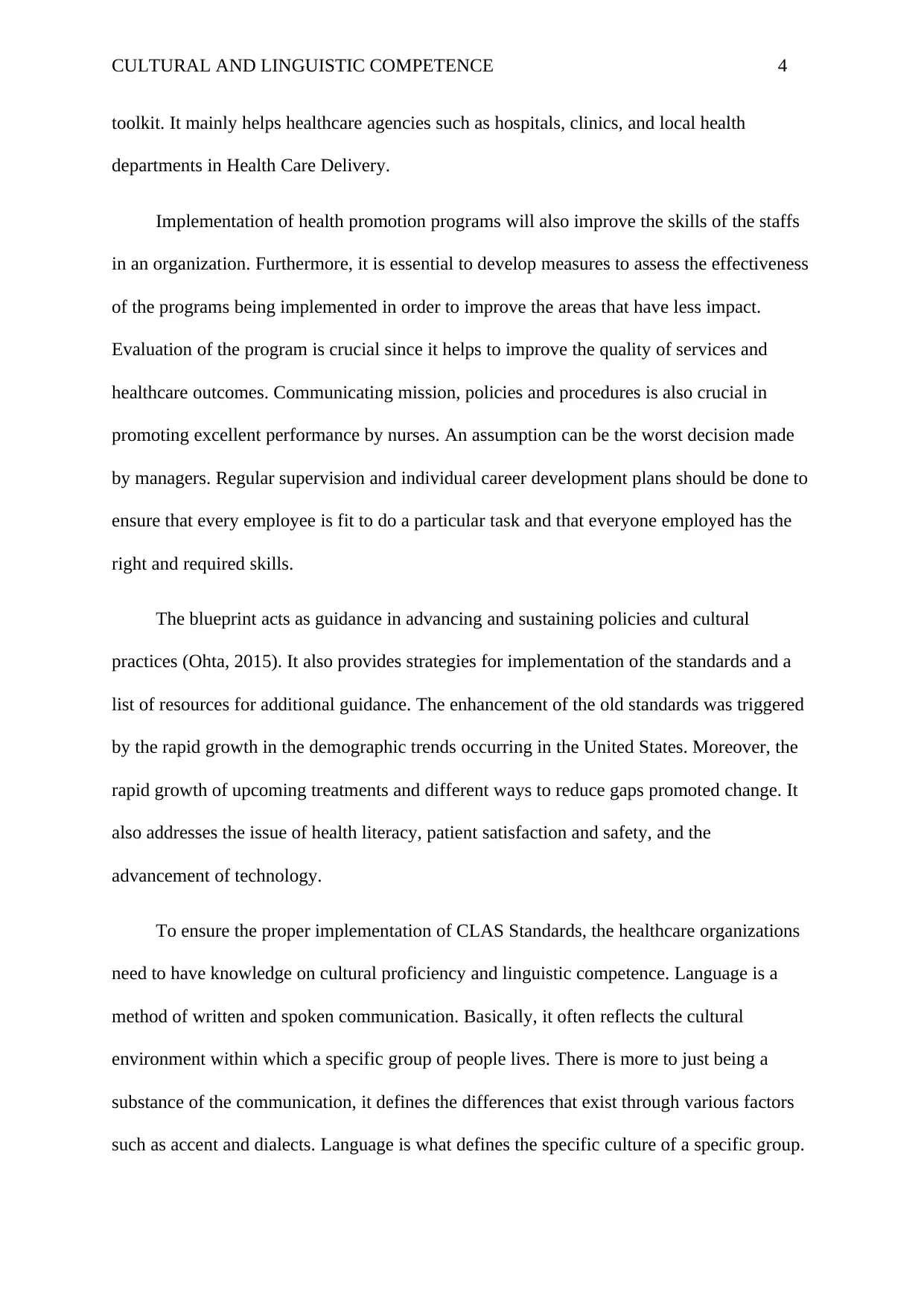
CULTURAL AND LINGUISTIC COMPETENCE 4
toolkit. It mainly helps healthcare agencies such as hospitals, clinics, and local health
departments in Health Care Delivery.
Implementation of health promotion programs will also improve the skills of the staffs
in an organization. Furthermore, it is essential to develop measures to assess the effectiveness
of the programs being implemented in order to improve the areas that have less impact.
Evaluation of the program is crucial since it helps to improve the quality of services and
healthcare outcomes. Communicating mission, policies and procedures is also crucial in
promoting excellent performance by nurses. An assumption can be the worst decision made
by managers. Regular supervision and individual career development plans should be done to
ensure that every employee is fit to do a particular task and that everyone employed has the
right and required skills.
The blueprint acts as guidance in advancing and sustaining policies and cultural
practices (Ohta, 2015). It also provides strategies for implementation of the standards and a
list of resources for additional guidance. The enhancement of the old standards was triggered
by the rapid growth in the demographic trends occurring in the United States. Moreover, the
rapid growth of upcoming treatments and different ways to reduce gaps promoted change. It
also addresses the issue of health literacy, patient satisfaction and safety, and the
advancement of technology.
To ensure the proper implementation of CLAS Standards, the healthcare organizations
need to have knowledge on cultural proficiency and linguistic competence. Language is a
method of written and spoken communication. Basically, it often reflects the cultural
environment within which a specific group of people lives. There is more to just being a
substance of the communication, it defines the differences that exist through various factors
such as accent and dialects. Language is what defines the specific culture of a specific group.
toolkit. It mainly helps healthcare agencies such as hospitals, clinics, and local health
departments in Health Care Delivery.
Implementation of health promotion programs will also improve the skills of the staffs
in an organization. Furthermore, it is essential to develop measures to assess the effectiveness
of the programs being implemented in order to improve the areas that have less impact.
Evaluation of the program is crucial since it helps to improve the quality of services and
healthcare outcomes. Communicating mission, policies and procedures is also crucial in
promoting excellent performance by nurses. An assumption can be the worst decision made
by managers. Regular supervision and individual career development plans should be done to
ensure that every employee is fit to do a particular task and that everyone employed has the
right and required skills.
The blueprint acts as guidance in advancing and sustaining policies and cultural
practices (Ohta, 2015). It also provides strategies for implementation of the standards and a
list of resources for additional guidance. The enhancement of the old standards was triggered
by the rapid growth in the demographic trends occurring in the United States. Moreover, the
rapid growth of upcoming treatments and different ways to reduce gaps promoted change. It
also addresses the issue of health literacy, patient satisfaction and safety, and the
advancement of technology.
To ensure the proper implementation of CLAS Standards, the healthcare organizations
need to have knowledge on cultural proficiency and linguistic competence. Language is a
method of written and spoken communication. Basically, it often reflects the cultural
environment within which a specific group of people lives. There is more to just being a
substance of the communication, it defines the differences that exist through various factors
such as accent and dialects. Language is what defines the specific culture of a specific group.
Paraphrase This Document
Need a fresh take? Get an instant paraphrase of this document with our AI Paraphraser
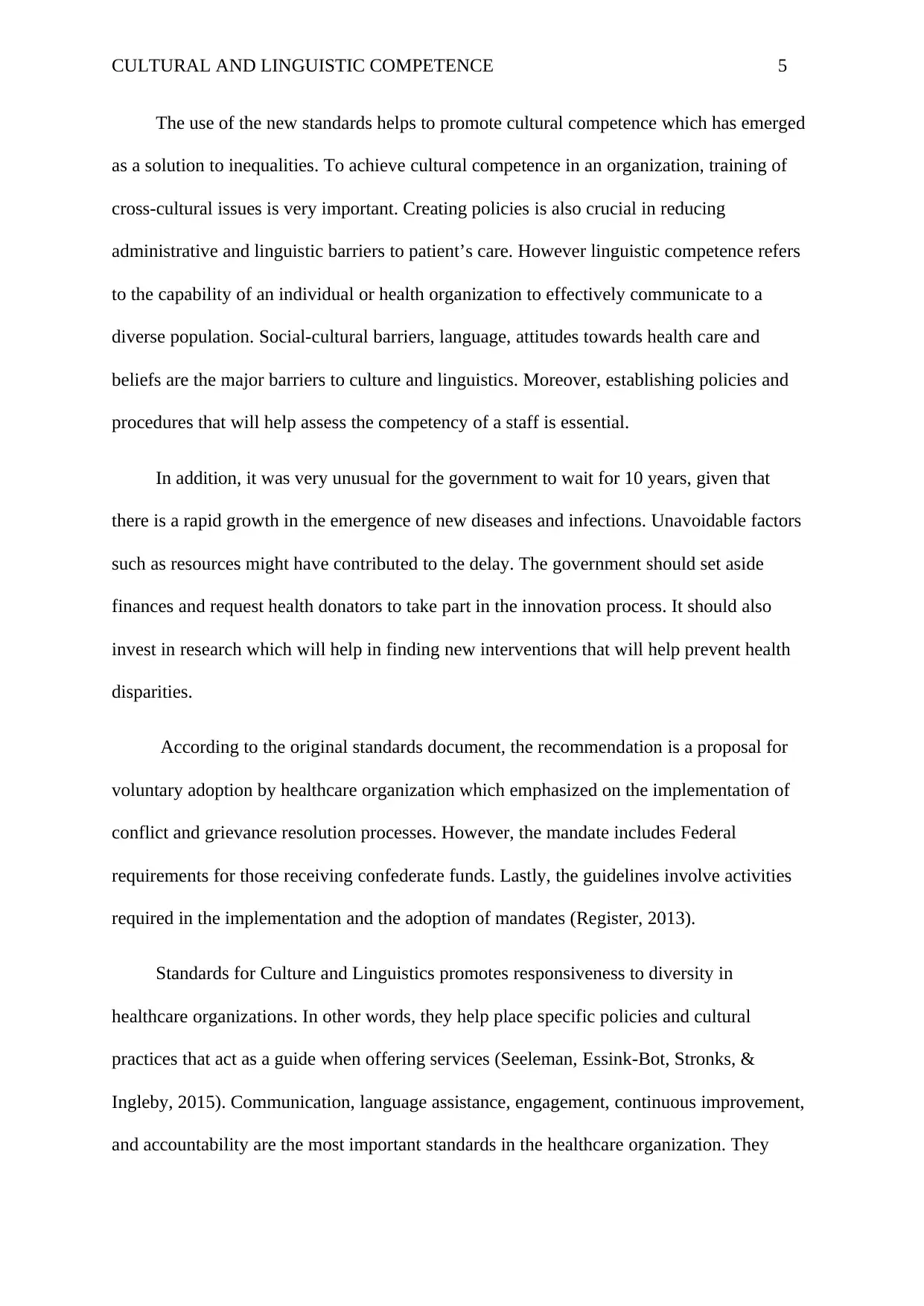
CULTURAL AND LINGUISTIC COMPETENCE 5
The use of the new standards helps to promote cultural competence which has emerged
as a solution to inequalities. To achieve cultural competence in an organization, training of
cross-cultural issues is very important. Creating policies is also crucial in reducing
administrative and linguistic barriers to patient’s care. However linguistic competence refers
to the capability of an individual or health organization to effectively communicate to a
diverse population. Social-cultural barriers, language, attitudes towards health care and
beliefs are the major barriers to culture and linguistics. Moreover, establishing policies and
procedures that will help assess the competency of a staff is essential.
In addition, it was very unusual for the government to wait for 10 years, given that
there is a rapid growth in the emergence of new diseases and infections. Unavoidable factors
such as resources might have contributed to the delay. The government should set aside
finances and request health donators to take part in the innovation process. It should also
invest in research which will help in finding new interventions that will help prevent health
disparities.
According to the original standards document, the recommendation is a proposal for
voluntary adoption by healthcare organization which emphasized on the implementation of
conflict and grievance resolution processes. However, the mandate includes Federal
requirements for those receiving confederate funds. Lastly, the guidelines involve activities
required in the implementation and the adoption of mandates (Register, 2013).
Standards for Culture and Linguistics promotes responsiveness to diversity in
healthcare organizations. In other words, they help place specific policies and cultural
practices that act as a guide when offering services (Seeleman, Essink-Bot, Stronks, &
Ingleby, 2015). Communication, language assistance, engagement, continuous improvement,
and accountability are the most important standards in the healthcare organization. They
The use of the new standards helps to promote cultural competence which has emerged
as a solution to inequalities. To achieve cultural competence in an organization, training of
cross-cultural issues is very important. Creating policies is also crucial in reducing
administrative and linguistic barriers to patient’s care. However linguistic competence refers
to the capability of an individual or health organization to effectively communicate to a
diverse population. Social-cultural barriers, language, attitudes towards health care and
beliefs are the major barriers to culture and linguistics. Moreover, establishing policies and
procedures that will help assess the competency of a staff is essential.
In addition, it was very unusual for the government to wait for 10 years, given that
there is a rapid growth in the emergence of new diseases and infections. Unavoidable factors
such as resources might have contributed to the delay. The government should set aside
finances and request health donators to take part in the innovation process. It should also
invest in research which will help in finding new interventions that will help prevent health
disparities.
According to the original standards document, the recommendation is a proposal for
voluntary adoption by healthcare organization which emphasized on the implementation of
conflict and grievance resolution processes. However, the mandate includes Federal
requirements for those receiving confederate funds. Lastly, the guidelines involve activities
required in the implementation and the adoption of mandates (Register, 2013).
Standards for Culture and Linguistics promotes responsiveness to diversity in
healthcare organizations. In other words, they help place specific policies and cultural
practices that act as a guide when offering services (Seeleman, Essink-Bot, Stronks, &
Ingleby, 2015). Communication, language assistance, engagement, continuous improvement,
and accountability are the most important standards in the healthcare organization. They
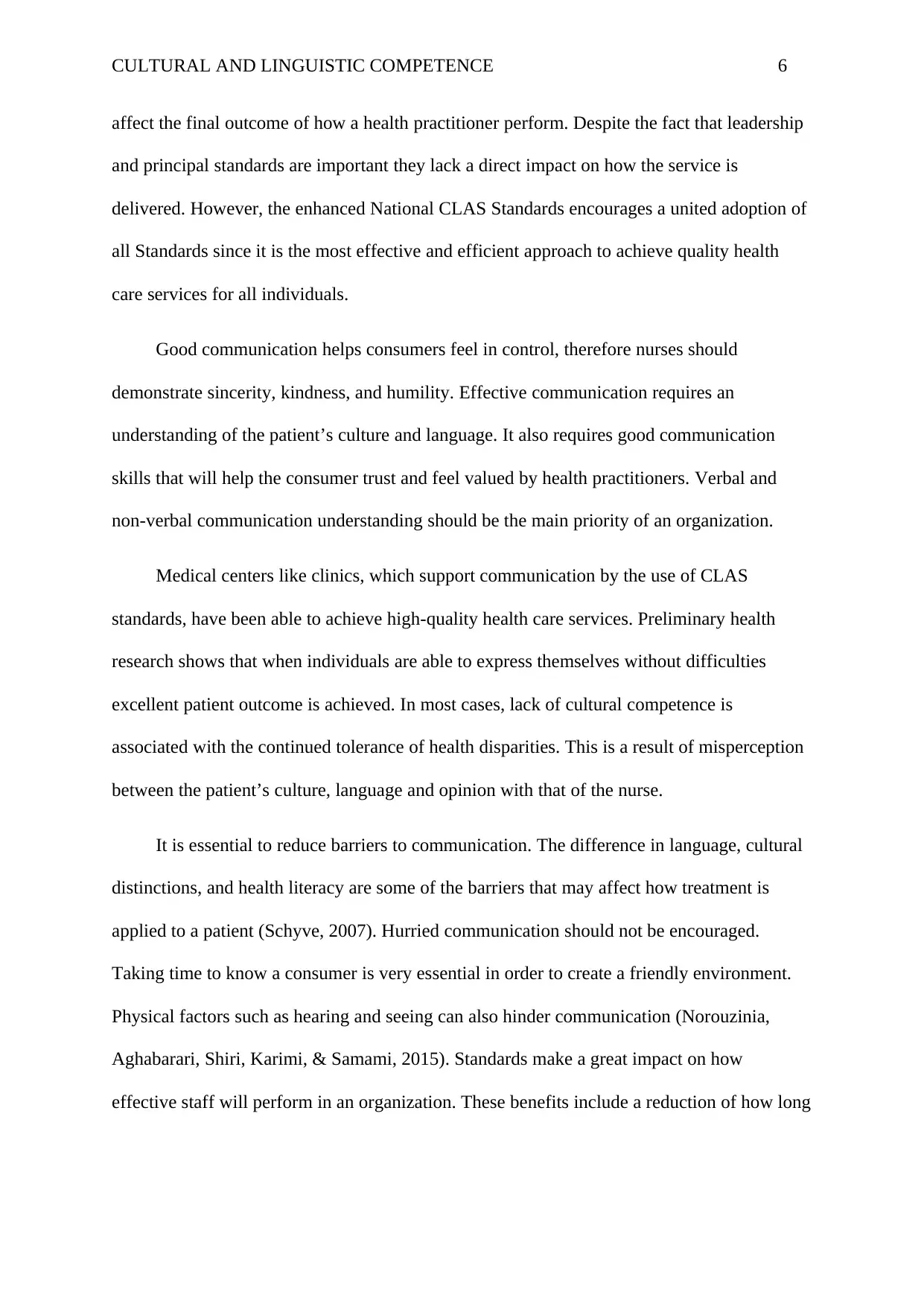
CULTURAL AND LINGUISTIC COMPETENCE 6
affect the final outcome of how a health practitioner perform. Despite the fact that leadership
and principal standards are important they lack a direct impact on how the service is
delivered. However, the enhanced National CLAS Standards encourages a united adoption of
all Standards since it is the most effective and efficient approach to achieve quality health
care services for all individuals.
Good communication helps consumers feel in control, therefore nurses should
demonstrate sincerity, kindness, and humility. Effective communication requires an
understanding of the patient’s culture and language. It also requires good communication
skills that will help the consumer trust and feel valued by health practitioners. Verbal and
non-verbal communication understanding should be the main priority of an organization.
Medical centers like clinics, which support communication by the use of CLAS
standards, have been able to achieve high-quality health care services. Preliminary health
research shows that when individuals are able to express themselves without difficulties
excellent patient outcome is achieved. In most cases, lack of cultural competence is
associated with the continued tolerance of health disparities. This is a result of misperception
between the patient’s culture, language and opinion with that of the nurse.
It is essential to reduce barriers to communication. The difference in language, cultural
distinctions, and health literacy are some of the barriers that may affect how treatment is
applied to a patient (Schyve, 2007). Hurried communication should not be encouraged.
Taking time to know a consumer is very essential in order to create a friendly environment.
Physical factors such as hearing and seeing can also hinder communication (Norouzinia,
Aghabarari, Shiri, Karimi, & Samami, 2015). Standards make a great impact on how
effective staff will perform in an organization. These benefits include a reduction of how long
affect the final outcome of how a health practitioner perform. Despite the fact that leadership
and principal standards are important they lack a direct impact on how the service is
delivered. However, the enhanced National CLAS Standards encourages a united adoption of
all Standards since it is the most effective and efficient approach to achieve quality health
care services for all individuals.
Good communication helps consumers feel in control, therefore nurses should
demonstrate sincerity, kindness, and humility. Effective communication requires an
understanding of the patient’s culture and language. It also requires good communication
skills that will help the consumer trust and feel valued by health practitioners. Verbal and
non-verbal communication understanding should be the main priority of an organization.
Medical centers like clinics, which support communication by the use of CLAS
standards, have been able to achieve high-quality health care services. Preliminary health
research shows that when individuals are able to express themselves without difficulties
excellent patient outcome is achieved. In most cases, lack of cultural competence is
associated with the continued tolerance of health disparities. This is a result of misperception
between the patient’s culture, language and opinion with that of the nurse.
It is essential to reduce barriers to communication. The difference in language, cultural
distinctions, and health literacy are some of the barriers that may affect how treatment is
applied to a patient (Schyve, 2007). Hurried communication should not be encouraged.
Taking time to know a consumer is very essential in order to create a friendly environment.
Physical factors such as hearing and seeing can also hinder communication (Norouzinia,
Aghabarari, Shiri, Karimi, & Samami, 2015). Standards make a great impact on how
effective staff will perform in an organization. These benefits include a reduction of how long
⊘ This is a preview!⊘
Do you want full access?
Subscribe today to unlock all pages.

Trusted by 1+ million students worldwide

CULTURAL AND LINGUISTIC COMPETENCE 7
inpatient will stay, increase in medication adherence, improved patient satisfaction, improved
financial outcomes and enhanced services for the growing diverse population.
National CLAS standards aim at addressing inequalities and disparities in health care
(Barksdale et al., 2016). In spite of the effort of trying to implement them in hospitals, they
should be reign forced when a student enrolls in a nursing school. Before practitioners can
understand other cultures, they should understand personal and organizational values and
beliefs. This will enable them to listen to the patient’s understanding of health, being
respectful, and negotiating treatment options.
In health organizations, linguistics competence requires interpretation and translation
services. The translation of written material will help to provide alternative information based
on the needs of the population being served, employing individuals that can translate both
verbal and non-verbal communication is necessary. It will enhance the accommodation of all
individuals that are in need of treatment. Individuals should be informed of the availability of
language assistance programs. Though it might seem to be time-consuming, it will help the
organization have an added advantage in the market.
Subsequently, the use of technology such as tracking systems is important when
implementing in order to improve the quality of services (Beach et al., 2004). For nurses to
achieve cultural and linguistic competency they need to be willing to accommodate all kinds
of patients. At times, pain can be a major hindrance of communicating. Nurses should make
an effort of assuring the patient that he or she has the support from the hospital. In other
words, a nurse can give painkillers that will help reduce pain which will allow the patient to
explain himself. Another way that nurses can use is the use is explaining health-related
jargons this will help to prevent the patient from fearing. Understanding the different roles of
inpatient will stay, increase in medication adherence, improved patient satisfaction, improved
financial outcomes and enhanced services for the growing diverse population.
National CLAS standards aim at addressing inequalities and disparities in health care
(Barksdale et al., 2016). In spite of the effort of trying to implement them in hospitals, they
should be reign forced when a student enrolls in a nursing school. Before practitioners can
understand other cultures, they should understand personal and organizational values and
beliefs. This will enable them to listen to the patient’s understanding of health, being
respectful, and negotiating treatment options.
In health organizations, linguistics competence requires interpretation and translation
services. The translation of written material will help to provide alternative information based
on the needs of the population being served, employing individuals that can translate both
verbal and non-verbal communication is necessary. It will enhance the accommodation of all
individuals that are in need of treatment. Individuals should be informed of the availability of
language assistance programs. Though it might seem to be time-consuming, it will help the
organization have an added advantage in the market.
Subsequently, the use of technology such as tracking systems is important when
implementing in order to improve the quality of services (Beach et al., 2004). For nurses to
achieve cultural and linguistic competency they need to be willing to accommodate all kinds
of patients. At times, pain can be a major hindrance of communicating. Nurses should make
an effort of assuring the patient that he or she has the support from the hospital. In other
words, a nurse can give painkillers that will help reduce pain which will allow the patient to
explain himself. Another way that nurses can use is the use is explaining health-related
jargons this will help to prevent the patient from fearing. Understanding the different roles of
Paraphrase This Document
Need a fresh take? Get an instant paraphrase of this document with our AI Paraphraser
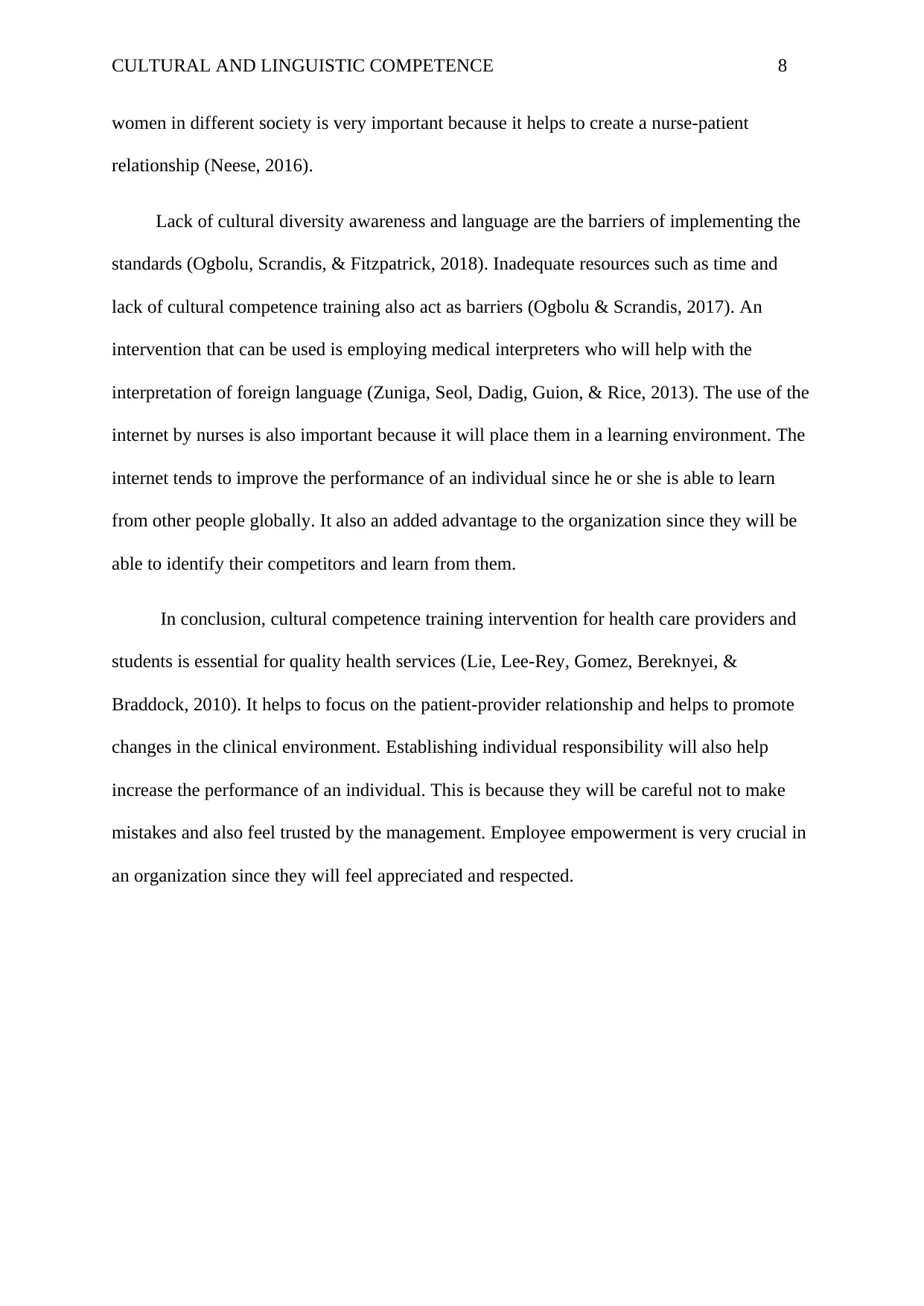
CULTURAL AND LINGUISTIC COMPETENCE 8
women in different society is very important because it helps to create a nurse-patient
relationship (Neese, 2016).
Lack of cultural diversity awareness and language are the barriers of implementing the
standards (Ogbolu, Scrandis, & Fitzpatrick, 2018). Inadequate resources such as time and
lack of cultural competence training also act as barriers (Ogbolu & Scrandis, 2017). An
intervention that can be used is employing medical interpreters who will help with the
interpretation of foreign language (Zuniga, Seol, Dadig, Guion, & Rice, 2013). The use of the
internet by nurses is also important because it will place them in a learning environment. The
internet tends to improve the performance of an individual since he or she is able to learn
from other people globally. It also an added advantage to the organization since they will be
able to identify their competitors and learn from them.
In conclusion, cultural competence training intervention for health care providers and
students is essential for quality health services (Lie, Lee-Rey, Gomez, Bereknyei, &
Braddock, 2010). It helps to focus on the patient-provider relationship and helps to promote
changes in the clinical environment. Establishing individual responsibility will also help
increase the performance of an individual. This is because they will be careful not to make
mistakes and also feel trusted by the management. Employee empowerment is very crucial in
an organization since they will feel appreciated and respected.
women in different society is very important because it helps to create a nurse-patient
relationship (Neese, 2016).
Lack of cultural diversity awareness and language are the barriers of implementing the
standards (Ogbolu, Scrandis, & Fitzpatrick, 2018). Inadequate resources such as time and
lack of cultural competence training also act as barriers (Ogbolu & Scrandis, 2017). An
intervention that can be used is employing medical interpreters who will help with the
interpretation of foreign language (Zuniga, Seol, Dadig, Guion, & Rice, 2013). The use of the
internet by nurses is also important because it will place them in a learning environment. The
internet tends to improve the performance of an individual since he or she is able to learn
from other people globally. It also an added advantage to the organization since they will be
able to identify their competitors and learn from them.
In conclusion, cultural competence training intervention for health care providers and
students is essential for quality health services (Lie, Lee-Rey, Gomez, Bereknyei, &
Braddock, 2010). It helps to focus on the patient-provider relationship and helps to promote
changes in the clinical environment. Establishing individual responsibility will also help
increase the performance of an individual. This is because they will be careful not to make
mistakes and also feel trusted by the management. Employee empowerment is very crucial in
an organization since they will feel appreciated and respected.
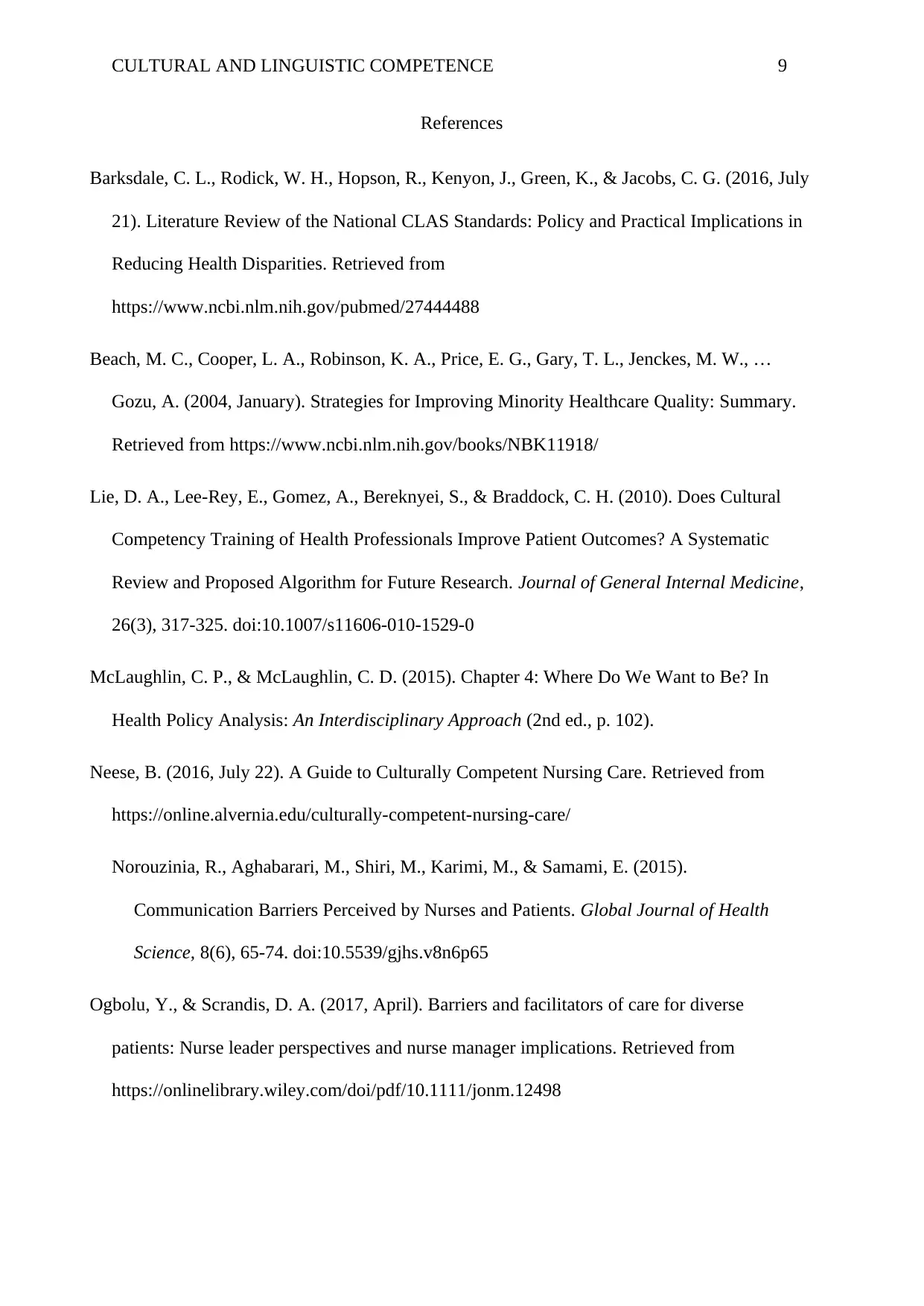
CULTURAL AND LINGUISTIC COMPETENCE 9
References
Barksdale, C. L., Rodick, W. H., Hopson, R., Kenyon, J., Green, K., & Jacobs, C. G. (2016, July
21). Literature Review of the National CLAS Standards: Policy and Practical Implications in
Reducing Health Disparities. Retrieved from
https://www.ncbi.nlm.nih.gov/pubmed/27444488
Beach, M. C., Cooper, L. A., Robinson, K. A., Price, E. G., Gary, T. L., Jenckes, M. W., …
Gozu, A. (2004, January). Strategies for Improving Minority Healthcare Quality: Summary.
Retrieved from https://www.ncbi.nlm.nih.gov/books/NBK11918/
Lie, D. A., Lee-Rey, E., Gomez, A., Bereknyei, S., & Braddock, C. H. (2010). Does Cultural
Competency Training of Health Professionals Improve Patient Outcomes? A Systematic
Review and Proposed Algorithm for Future Research. Journal of General Internal Medicine,
26(3), 317-325. doi:10.1007/s11606-010-1529-0
McLaughlin, C. P., & McLaughlin, C. D. (2015). Chapter 4: Where Do We Want to Be? In
Health Policy Analysis: An Interdisciplinary Approach (2nd ed., p. 102).
Neese, B. (2016, July 22). A Guide to Culturally Competent Nursing Care. Retrieved from
https://online.alvernia.edu/culturally-competent-nursing-care/
Norouzinia, R., Aghabarari, M., Shiri, M., Karimi, M., & Samami, E. (2015).
Communication Barriers Perceived by Nurses and Patients. Global Journal of Health
Science, 8(6), 65-74. doi:10.5539/gjhs.v8n6p65
Ogbolu, Y., & Scrandis, D. A. (2017, April). Barriers and facilitators of care for diverse
patients: Nurse leader perspectives and nurse manager implications. Retrieved from
https://onlinelibrary.wiley.com/doi/pdf/10.1111/jonm.12498
References
Barksdale, C. L., Rodick, W. H., Hopson, R., Kenyon, J., Green, K., & Jacobs, C. G. (2016, July
21). Literature Review of the National CLAS Standards: Policy and Practical Implications in
Reducing Health Disparities. Retrieved from
https://www.ncbi.nlm.nih.gov/pubmed/27444488
Beach, M. C., Cooper, L. A., Robinson, K. A., Price, E. G., Gary, T. L., Jenckes, M. W., …
Gozu, A. (2004, January). Strategies for Improving Minority Healthcare Quality: Summary.
Retrieved from https://www.ncbi.nlm.nih.gov/books/NBK11918/
Lie, D. A., Lee-Rey, E., Gomez, A., Bereknyei, S., & Braddock, C. H. (2010). Does Cultural
Competency Training of Health Professionals Improve Patient Outcomes? A Systematic
Review and Proposed Algorithm for Future Research. Journal of General Internal Medicine,
26(3), 317-325. doi:10.1007/s11606-010-1529-0
McLaughlin, C. P., & McLaughlin, C. D. (2015). Chapter 4: Where Do We Want to Be? In
Health Policy Analysis: An Interdisciplinary Approach (2nd ed., p. 102).
Neese, B. (2016, July 22). A Guide to Culturally Competent Nursing Care. Retrieved from
https://online.alvernia.edu/culturally-competent-nursing-care/
Norouzinia, R., Aghabarari, M., Shiri, M., Karimi, M., & Samami, E. (2015).
Communication Barriers Perceived by Nurses and Patients. Global Journal of Health
Science, 8(6), 65-74. doi:10.5539/gjhs.v8n6p65
Ogbolu, Y., & Scrandis, D. A. (2017, April). Barriers and facilitators of care for diverse
patients: Nurse leader perspectives and nurse manager implications. Retrieved from
https://onlinelibrary.wiley.com/doi/pdf/10.1111/jonm.12498
⊘ This is a preview!⊘
Do you want full access?
Subscribe today to unlock all pages.

Trusted by 1+ million students worldwide
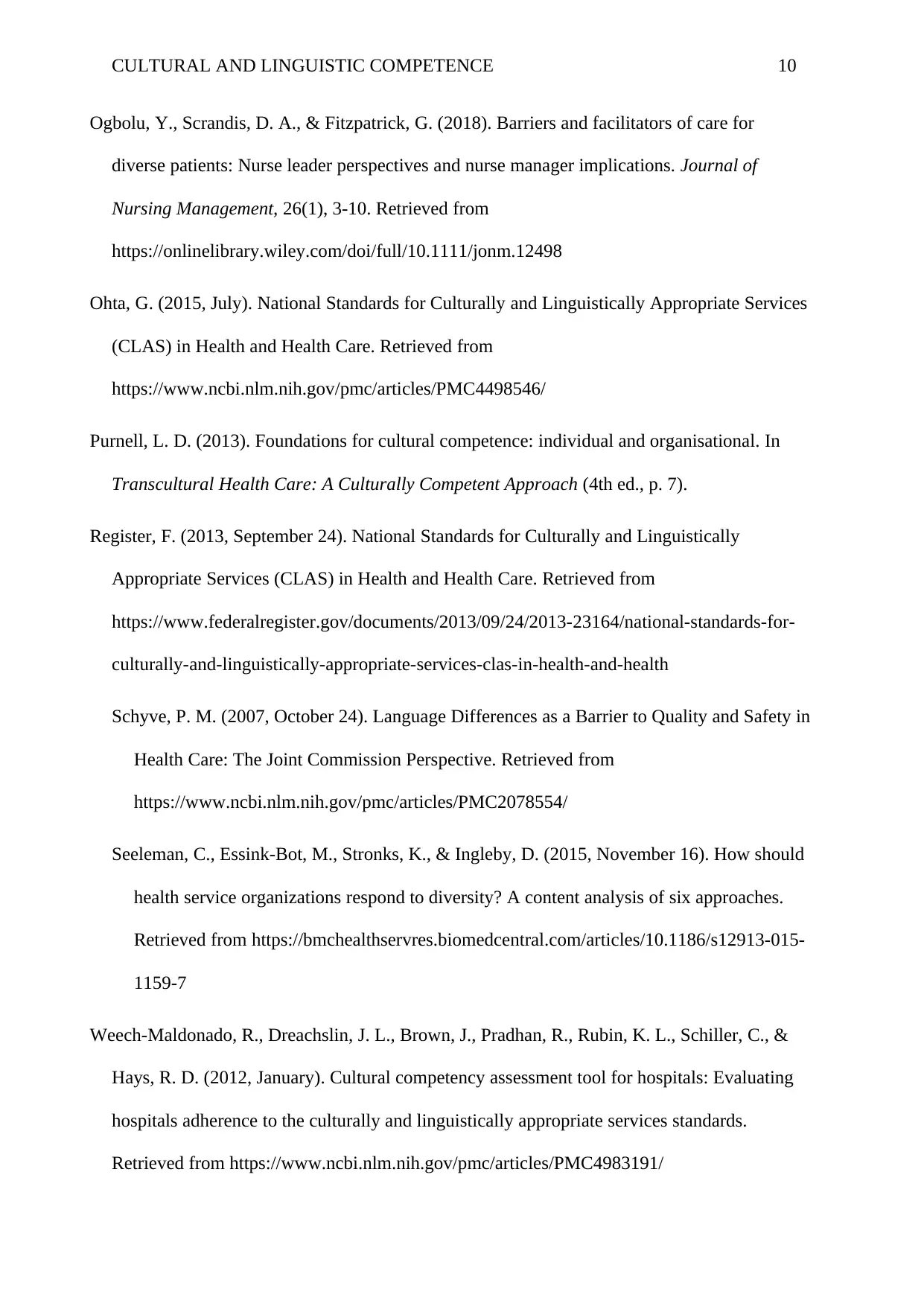
CULTURAL AND LINGUISTIC COMPETENCE 10
Ogbolu, Y., Scrandis, D. A., & Fitzpatrick, G. (2018). Barriers and facilitators of care for
diverse patients: Nurse leader perspectives and nurse manager implications. Journal of
Nursing Management, 26(1), 3-10. Retrieved from
https://onlinelibrary.wiley.com/doi/full/10.1111/jonm.12498
Ohta, G. (2015, July). National Standards for Culturally and Linguistically Appropriate Services
(CLAS) in Health and Health Care. Retrieved from
https://www.ncbi.nlm.nih.gov/pmc/articles/PMC4498546/
Purnell, L. D. (2013). Foundations for cultural competence: individual and organisational. In
Transcultural Health Care: A Culturally Competent Approach (4th ed., p. 7).
Register, F. (2013, September 24). National Standards for Culturally and Linguistically
Appropriate Services (CLAS) in Health and Health Care. Retrieved from
https://www.federalregister.gov/documents/2013/09/24/2013-23164/national-standards-for-
culturally-and-linguistically-appropriate-services-clas-in-health-and-health
Schyve, P. M. (2007, October 24). Language Differences as a Barrier to Quality and Safety in
Health Care: The Joint Commission Perspective. Retrieved from
https://www.ncbi.nlm.nih.gov/pmc/articles/PMC2078554/
Seeleman, C., Essink-Bot, M., Stronks, K., & Ingleby, D. (2015, November 16). How should
health service organizations respond to diversity? A content analysis of six approaches.
Retrieved from https://bmchealthservres.biomedcentral.com/articles/10.1186/s12913-015-
1159-7
Weech-Maldonado, R., Dreachslin, J. L., Brown, J., Pradhan, R., Rubin, K. L., Schiller, C., &
Hays, R. D. (2012, January). Cultural competency assessment tool for hospitals: Evaluating
hospitals adherence to the culturally and linguistically appropriate services standards.
Retrieved from https://www.ncbi.nlm.nih.gov/pmc/articles/PMC4983191/
Ogbolu, Y., Scrandis, D. A., & Fitzpatrick, G. (2018). Barriers and facilitators of care for
diverse patients: Nurse leader perspectives and nurse manager implications. Journal of
Nursing Management, 26(1), 3-10. Retrieved from
https://onlinelibrary.wiley.com/doi/full/10.1111/jonm.12498
Ohta, G. (2015, July). National Standards for Culturally and Linguistically Appropriate Services
(CLAS) in Health and Health Care. Retrieved from
https://www.ncbi.nlm.nih.gov/pmc/articles/PMC4498546/
Purnell, L. D. (2013). Foundations for cultural competence: individual and organisational. In
Transcultural Health Care: A Culturally Competent Approach (4th ed., p. 7).
Register, F. (2013, September 24). National Standards for Culturally and Linguistically
Appropriate Services (CLAS) in Health and Health Care. Retrieved from
https://www.federalregister.gov/documents/2013/09/24/2013-23164/national-standards-for-
culturally-and-linguistically-appropriate-services-clas-in-health-and-health
Schyve, P. M. (2007, October 24). Language Differences as a Barrier to Quality and Safety in
Health Care: The Joint Commission Perspective. Retrieved from
https://www.ncbi.nlm.nih.gov/pmc/articles/PMC2078554/
Seeleman, C., Essink-Bot, M., Stronks, K., & Ingleby, D. (2015, November 16). How should
health service organizations respond to diversity? A content analysis of six approaches.
Retrieved from https://bmchealthservres.biomedcentral.com/articles/10.1186/s12913-015-
1159-7
Weech-Maldonado, R., Dreachslin, J. L., Brown, J., Pradhan, R., Rubin, K. L., Schiller, C., &
Hays, R. D. (2012, January). Cultural competency assessment tool for hospitals: Evaluating
hospitals adherence to the culturally and linguistically appropriate services standards.
Retrieved from https://www.ncbi.nlm.nih.gov/pmc/articles/PMC4983191/
Paraphrase This Document
Need a fresh take? Get an instant paraphrase of this document with our AI Paraphraser
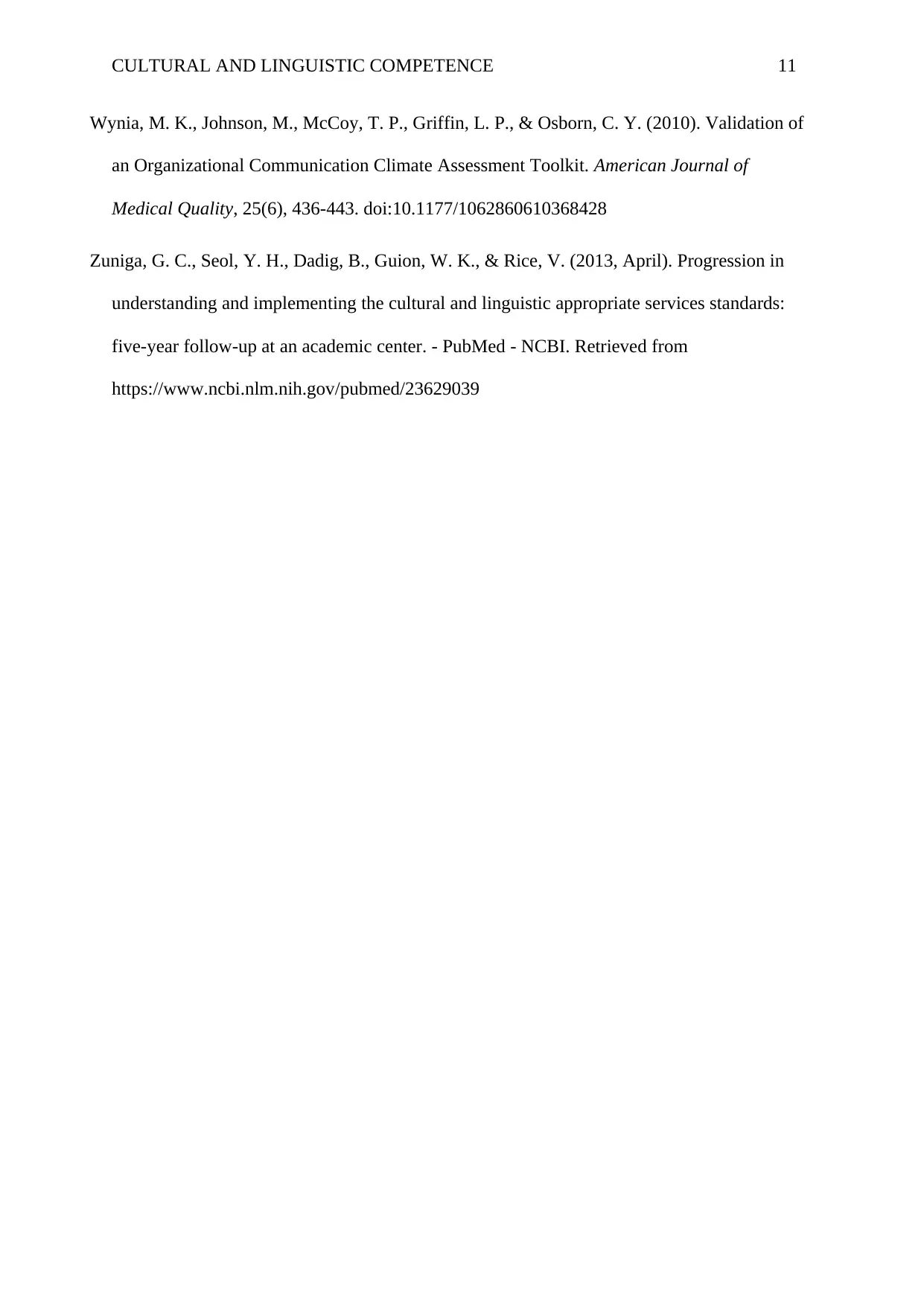
CULTURAL AND LINGUISTIC COMPETENCE 11
Wynia, M. K., Johnson, M., McCoy, T. P., Griffin, L. P., & Osborn, C. Y. (2010). Validation of
an Organizational Communication Climate Assessment Toolkit. American Journal of
Medical Quality, 25(6), 436-443. doi:10.1177/1062860610368428
Zuniga, G. C., Seol, Y. H., Dadig, B., Guion, W. K., & Rice, V. (2013, April). Progression in
understanding and implementing the cultural and linguistic appropriate services standards:
five-year follow-up at an academic center. - PubMed - NCBI. Retrieved from
https://www.ncbi.nlm.nih.gov/pubmed/23629039
Wynia, M. K., Johnson, M., McCoy, T. P., Griffin, L. P., & Osborn, C. Y. (2010). Validation of
an Organizational Communication Climate Assessment Toolkit. American Journal of
Medical Quality, 25(6), 436-443. doi:10.1177/1062860610368428
Zuniga, G. C., Seol, Y. H., Dadig, B., Guion, W. K., & Rice, V. (2013, April). Progression in
understanding and implementing the cultural and linguistic appropriate services standards:
five-year follow-up at an academic center. - PubMed - NCBI. Retrieved from
https://www.ncbi.nlm.nih.gov/pubmed/23629039
1 out of 11
Related Documents
Your All-in-One AI-Powered Toolkit for Academic Success.
+13062052269
info@desklib.com
Available 24*7 on WhatsApp / Email
![[object Object]](/_next/static/media/star-bottom.7253800d.svg)
Unlock your academic potential
Copyright © 2020–2025 A2Z Services. All Rights Reserved. Developed and managed by ZUCOL.





